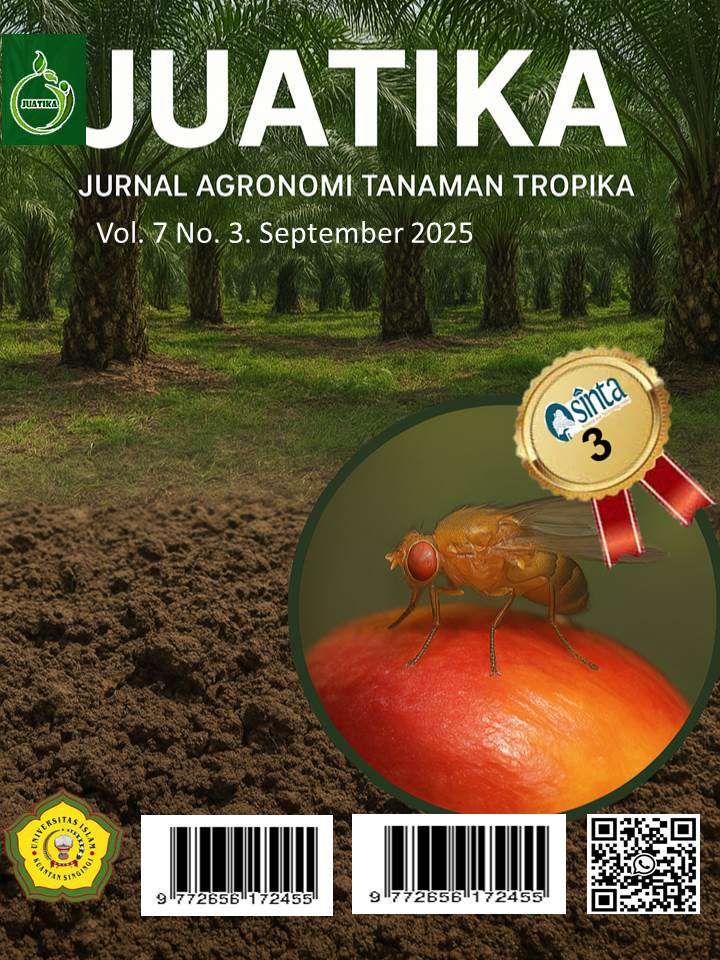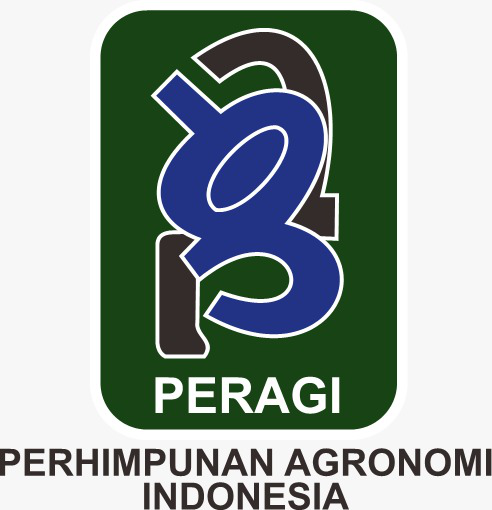Optimizing Oil Palm (Elais guinensis L.) Carbon Management in Tidal Lands to Support Sustainable Plantations
Abstract
Oil palm plantations in tidal areas face complex challenges in optimizing carbon management to achieve sustainable production. This study aims to analyze the dynamics of carbon stocks across various management systems of oil palm plantations in tidal zones and to develop optimization strategies for sustainable production. The research was conducted in Menten Village, Rambutan District, Musi Banyuasin Regency, South Sumatra, employing a factorial Randomized Complete Block Design with factors including water management systems (conventional, semi-intensive, conservation, optimization) and plant age categories (3–5, 6–10, 11–15, 16–20, and 21–25 years). CO₂ emissions and sequestration were measured using the LI-COR LI-8100A system; biomass was assessed through allometric equations and destructive sampling methods, while soil and water parameters were analyzed using standard procedures. The results demonstrated that the optimized system incorporating smart drainage achieved the best performance, exhibiting the lowest CO₂ emissions (6.2 Mg C/ha/year), the highest carbon absorption (21.5 Mg C/ha/year), and a positive net carbon balance (+15.3 Mg C/ha/year) with an efficiency of 346.8%. This system also increased fresh fruit bunch (FFB) productivity from 18.5 tons/ha/year under conventional management to 26.4 tons/ha/year, with superior quality metrics (oil content: 27.2%, acid value: 1.4%, crude palm oil yield: 25.2%). Total carbon stock progressively increased from 23.7 Mg C/ha in young plants to 147.9 Mg C/ha in mature plants, with an optimal sequestration rate of 17.8 Mg C/ha/year. The implementation of smart drainage, combined with IoT technology and biochar application, effectively optimized edaphic conditions by increasing soil pH to 4.8, raising organic carbon content to 4.2%, reducing bulk density to 0.68 g/cm³, and controlling salinity at 1.2 dS/m. This study confirms that oil palm plantations on tidal lands can achieve sustainability through precision agriculture practices that integrate precision water management, biochar application, and real-time monitoring to optimize the balance between productivity and carbon conservation.
Downloads
References
Ahmed Mohammed, M. E., Alhajhoj, M. R., Ali-Dinar, H. M., & Munir, M. (2020). Impact of a novel water-saving subsurface irrigation system on water productivity, photosynthetic characteristics, yield, and fruit quality of date palm under arid conditions. Agronomy, 10(9), 1265. https://doi.org/10.3390/agronomy10091265
Alimin, M., Nurudin, M., Hanudin, E., & Utami, S. N. H. (2022). Distribution of carbon stocks in peat bottom based on thickness class in Pelalawan Village (Riau Province, Indonesia). Polish Journal of Soil Science, 55(2), 105–120. http://dx.doi.org/10.17951/pjss.2022.55.2.105-120
Andriyanningsih, S., Siregar, I. Z., & Tarigan, S. D. (2024, August). Biodiversity and ecosystem functioning in palm oil landscapes: A systematic literature review. In IOP Conference Series: Earth and Environmental Science (Vol. 1379, No. 1, p. 012006). IOP Publishing. https://doi.org/10.1088/1755-1315/1379/1/012006
Badrudin, U., Ghulamahdi, M., Purwoko, B. S., & Pratiwi, E. (2023). Pengaruh aplikasi mikroba terhadap fisiologis beberapa varietas padi fase vegetatif pada kondisi salin tergenang. Agro Bali: Agricultural Journal, 6(3), 621–635. https://doi.org/10.37637/ab.v6i3.1279
Comeau, L. P., Hergoualc'h, K., Hartill, J., Smith, J., Verchot, L. V., Peak, D., & Salim, A. M. (2016). How do the heterotrophic and the total soil respiration of an oil palm plantation on peat respond to nitrogen fertilizer application? Geoderma, 268, 41–51. https://doi.org/10.1016/j.geoderma.2016.01.016
Cooper, H. V., Evers, S., Aplin, P., Crout, N., Dahalan, M. P. B., & Sjogersten, S. (2020). Greenhouse gas emissions resulting from conversion of peat swamp forest to oil palm plantation. Nature Communications, 11(1), 407. https://doi.org/10.1038/s41467-020-14298-w
Dariah, A., Jubaedah, J., Wahyunto, W., & Pitono, J. (2013). Pengaruh tinggi muka air saluran drainase, pupuk, dan amelioran terhadap emisi CO₂ pada perkebunan kelapa sawit di lahan gambut. Industrial Crops Research Journal, 19(2), 66–71.
Dariah, A., Sutono, S., Nurida, N. L., Hartatik, W., & Pratiwi, E. P. A. (2014). Pembenah tanah untuk meningkatkan produktivitas lahan pertanian. Jurnal Sumberdaya Lahan, 8(3), 67–84.
Dassou, O., Nodichao, L., Aholoukpè, H., Cakpo, Y., & Jourdan, C. (2021). Improving the methodology for root biomass estimation in monocotyledonous tree plantations: Case of oil palm (Elaeis guineensis Jacq.) in West Africa. Plant and Soil, 465(1), 593–611. https://doi.org/10.1007/s11104-021-04939-4
Endriani, E., & Kurniawan, A. (2018). Konservasi tanah dan karbon melalui pemanfaatan biochar pada pertanaman kedelai. Jurnal Ilmiah Ilmu Terapan Universitas Jambi, 2(2), 93–106.
Fahmi, A., & Khairullah, I. (2018). Ameliorasi tanah sulfat masam untuk budidaya padi. In Inovasi teknologi lahan rawa pasang surut sulfat masam. Balai Penelitian Lahan Rawa.
Guillaume, T., Kotowska, M. M., Hertel, D., Knohl, A., Krashevska, V., Murtilaksono, K., & Kuzyakov, Y. (2022). Carbon costs and benefits of Indonesian rainforest conversion to plantations. Nature Communications, 13(1), 2388. https://doi.org/10.1038/s41467-018-04755-y
Gutenberg, L., Krauss, K. W., Qu, J. J., Ahn, C., Hogan, D., Zhu, Z., & Xu, C. (2019). Carbon dioxide emissions and methane flux from forested wetland soils of the Great Dismal Swamp, USA. Environmental Management, 64(2), 190–200. https://doi.org/10.1007/s00267-019-01177-4
Hadi, A., Inubushi, K., Purnomo, E., Razie, F., Yamakawa, K., & Tsuruta, H. (2023). Greenhouse gas emissions from tropical peatlands of Kalimantan, Indonesia. Nutrient Cycling in Agroecosystems, 125(1), 45–62.
Harahap, F., Silveira, S., & Khatiwada, D. (2019). Cost competitiveness of palm oil biodiesel production in Indonesia. Energy, 170, 62–72.
Haron, K., Mohamed, A., Rajpar, M. N., & Farooq, S. (2021). Roles of plantation crops in climate change mitigation: A review. Journal of Cleaner Production, 288, 125676.
Intyas, C. A., Putritamara, J. A., & Haryati, N. (2022). Dinamika agrobisnis era VUCA: Volatility, uncertainty, complexity, ambiguity. Universitas Brawijaya Press.
Jayalath, N., Mosley, L. M., Fitzpatrick, R. W., & Marschner, P. (2016). Addition of organic matter influences pH changes in reduced and oxidized acid sulfate soils. Geoderma, 262, 125–132. https://doi.org/10.1016/j.geoderma.2015.08.012
Kementerian Pertanian. (2024). Statistik perkebunan Indonesia 2022–2024. Direktorat Jenderal Perkebunan.
Lewis, K., Rumpang, E., Kho, L. K., McCalmont, J., Teh, Y. A., Gallego-Sala, A., & Hill, T. C. (2020). An assessment of oil palm plantation aboveground biomass stocks on tropical peat using destructive and non-destructive methods. Scientific Reports, 10(1), 2230.
Lim, S. S., Baah-Acheamfour, M., Choi, W. J., Arshad, M. A., Fatemi, F., & Singh, A. K. (2023). Soil carbon sequestration in agroforestry systems: A global meta-analysis. Agriculture, Ecosystems & Environment, 342, 108239.
Maftuah, E., & Nurzakiah, S. (2017). Pemulihan dan konservasi lahan gambut. In Agroekologi rawa (pp. 470–500).
Masganti, M., Wahyunto, W., Dariah, A., Nurhayati, N., & Yusuf, R. (2020). Karakteristik dan potensi pemanfaatan lahan gambut terdegradasi di Provinsi Riau. Jurnal Sumberdaya Lahan, 8(1), 59–66.
Murdiyarso, D., Dewi, S., Lawrence, D., & Seymour, F. (2019). Indonesia’s forest moratorium: Impacts and next steps (WRI Working Paper). World Resources Institute.
Murphy, D. J. (2024). Carbon sequestration by tropical trees and crops: A case study of oil palm. Agriculture, 14(7), 1133. https://doi.org/10.3390/agriculture14071133
Ogwu, M. C., & Kosoe, E. A. (2025). Integrating green infrastructure into sustainable agriculture to enhance soil health, biodiversity, and microclimate resilience. Sustainability, 17(9), 3838.
Paoli, G. D., Wells, P. L., Meijaard, E., Struebig, M. J., Marshall, A. J., Obidzinski, K., & Slik, F. (2022). Biodiversity conservation in oil palm production landscapes in Southeast Asia. Annual Review of Environment and Resources, 47, 311–348.
Rahman, N., Giller, K. E., de Neergaard, A., Magid, J., van de Ven, G., & Bruun, T. B. (2021). The effects of management practices on soil organic carbon stocks of oil palm plantations in Sumatra, Indonesia. Journal of Environmental Management, 278, 111446. https://doi.org/10.1016/j.jenvman.2020.111446
Reca, J., Trillo, C., Sánchez, J. A., Martínez, J., & Valera, D. (2018). Optimization model for on-farm irrigation management of Mediterranean greenhouse crops using desalinated and saline water from different sources. Agricultural Systems, 166, 173–183. https://doi.org/10.1016/j.agsy.2018.02.004
Rhebergen, T., Fairhurst, T., Zingore, S., Fisher, M., Oberthür, T., & Whitbread, A. (2023). Climate, soil and land-use based land suitability evaluation for oil palm production in Ghana. European Journal of Agronomy, 142, 126648.
Rosadi, B., Suhardjo, H., & Bachri, S. N. (2018). Evaluasi kesesuaian lahan untuk tanaman kelapa sawit di lahan pasang surut Kabupaten Tanjung Jabung Timur Provinsi Jambi. Jurnal Penelitian Universitas Jambi Seri Sains, 20(1), 59–70.
Sabiham, S., & Sukarman, S. (2022). Pengelolaan lahan sulfat masam untuk pertanian berkelanjutan. Jurnal Tanah dan Iklim, 46(1), 71–82.
Sharif, Z. B. M., Taib, N. B. M., Yusof, M. S. B., Rahim, M. Z. B., Tobi, A. L. B. M., & Othman, M. S. B. (2017, May). Study on handling process and quality degradation of oil palm fresh fruit bunches (FFB). In IOP Conference Series: Materials Science and Engineering (Vol. 203, No. 1, p. 012027). IOP Publishing.
Sitzmann, T. J., Celi, L., Moretti, B., Padoan, E., Tagliavini, S., Zavattaro, L., & Grignani, C. (2025). Suitability of renewable organic materials for the synthesis of organo-mineral fertilizers: Driving factors and replacement of peat. Heliyon, 11(4).
Sulaeman, Y., Maftuah, E., Noor, M., Hairani, A., Nurzakiah, S., Mukhlis, M., et al. (2024). Coastal acid-sulfate soils of Kalimantan, Indonesia, for food security: Characteristics, management, and future directions. Resources, 13(3), 36.
Tan, B. A., Nair, A., Zakaria, M. I. S., Low, J. Y. S., Kua, S. F., Koo, K. L., & Appleton, D. R. (2023). Free fatty acid formation points in palm oil processing and the impact on oil quality. Agriculture, 13(5), 957.
Wigena, I. G. P., & Dariah, A. (2021). Teknologi pengelolaan air lahan pasang surut untuk pertanian berkelanjutan. Jurnal Sumberdaya Lahan, 15(2), 89–104.
Yeni, I. (2021). Uji efektivitas leguminosae cover crop (LCC) Mucuna bracteata dan Mucuna pruriens sebagai tumbuhan penutup tanah pada beberapa jenis tanah marginal [Doctoral dissertation, Universitas Andalas].
Copyright (c) 2025 Ismail Ismail, Cecep Wahyudin, Triyo Haryono

This work is licensed under a Creative Commons Attribution 4.0 International License.
Authors who publish with Jurnal Agronomi Tanaman Tropika (JUATIKA) agree to the following terms:
Authors retain copyright and grant the Jurnal Agronomi Tanaman Tropika (JUATIKA) right of first publication with the work simultaneously licensed under a Creative Commons Attribution License (CC BY 4.0) that allows others to share (copy and redistribute the material in any medium or format) and adapt (remix, transform, and build upon the material for any purpose, even commercially) with an acknowledgment of the work's authorship and initial publication in Jurnal Agronomi Tanaman Tropika (JUATIKA).
Authors are able to enter into separate, additional contractual arrangements for the non-exclusive distribution of the journal's published version of the work (e.g., post it to an institutional repository or publish it in a book), with an acknowledgment of its initial publication in Jurnal Agronomi Tanaman Tropika (JUATIKA). Authors are permitted and encouraged to post their work online (e.g., in institutional repositories or on their website) prior to and during the submission process, as it can lead to productive exchanges, as well as earlier and greater citation of published work.







 More Information
More Information



